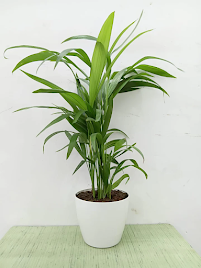Summer can be a challenging season for plant lovers. With soaring temperatures and intense sunlight, your green companions need extra care—especially when it comes to watering. While water is essential, improper watering can do more harm than good. At RootsRaja, we believe that thriving plants start with the right watering techniques.
This guide will walk you through the essential do’s and don’ts of summer watering to keep your greens happy and hydrated.
Let’s explore the top watering practices every plant parent should know.
Why Summer Watering Needs Special Attention
During summer, heat increases evaporation, causing the soil to dry out much faster. While it’s tempting to water your plants frequently, doing so without a plan can cause root rot, fungal diseases, or plant stress. Whether it’s a
Fiddle Leaf Fig, Snake Plant, or
Calathea Insignis, understanding your plant’s unique needs and adjusting your routine is key.
Do’s: Smart Watering Practices for Summer
Water Early in the Morning
Watering during early morning hours gives your plants time to absorb moisture before the day gets hot. It reduces evaporation and allows the roots of sun-lovers like Areca Palm and Money Plant to drink in peace.
Use Mulch to Retain Moisture
Adding a layer of mulch around your Peace Lily or garden beds helps retain moisture, maintain consistent soil temperature, and suppress weed growth. It’s especially helpful for outdoor plants like Hibiscus and Bougainvillea.
Check Soil Moisture Before Watering
Before watering, insert your finger 1–2 inches into the soil. If it's dry, go ahead and water. This trick works well for all kinds of plants—especially potted ones like Syngonium and ZZ Plant.
Water Deeply, Not Frequently
Rather than giving your Rubber Plant or Philodendron a daily splash, water deeply every few days. This promotes stronger, deeper root systems that can withstand dry spells.
Use Drip Irrigation or a Soaker Hose
Perfect for garden beds and outdoor containers, these methods deliver water directly to the roots, minimizing evaporation and waste.
Group Plants Based on Water Needs
Plants like succulents and cacti need far less water than thirsty varieties like Boston Ferns or Alocasias. Grouping them helps avoid over- or under-watering.
Choose Self-Watering Pots
For indoor favorites like Pothos and Aglaonema, self-watering pots ensure consistent moisture levels, even when you're away.
Don’ts: Common Summer Watering Mistakes
Don’t Water During Midday Heat
Avoid watering between 11 a.m. and 4 p.m. when the sun is at its peak. Water can evaporate before reaching roots—or worse, scorch the leaves.
Don’t Splash Water on Leaves
Always aim to water the soil, not the foliage. Wet leaves in the summer sun can lead to fungal diseases or sunburn, especially in plants like Calatheas and Marantas.
Don’t Rely on Rainfall Alone
Even if it rains, check the soil before assuming your Spider Plant or Jade Plant has had enough. Summer rains can be brief and superficial.
Don’t Use Cold Tap Water
Cold water can shock roots—especially in tropical plants like
Monstera or Areca Palm. Let it sit until it reaches room temperature.
Don’t Ignore Plant-Specific Needs
A blanket watering schedule won’t work. Succulents like Echeveria need far less water than moisture-loving plants like Ferns or Dieffenbachia. Know your plants!
Don’t Flood the Pot or Soil
Too much water causes root rot and mold. Make sure your pots have proper drainage and never let them sit in excess water.
Bonus Tips for Summer Plant Care
- Watch for Wilting: It may signal a need for water or heat stress. Check the soil before watering.
- Try Water-Storing Crystals: Great for potted plants during vacations or extreme heat.
- Provide Shade: Use a shade cloth or move sensitive plants like Anthurium to a shaded area during peak heat.
Keep Your Plants Thriving with RootsRaja
Whether you're growing a succulent collection on your balcony or maintaining a full-fledged tropical indoor jungle, summer watering is all about timing, technique, and observation. At
RootsRaja, we’re passionate about helping you keep your plants healthy year-round—with the right tools, tips, and care advice.
Final Thoughts & Eco Tip
Water wisely—not just for your plants, but for the planet. Collect rainwater or reuse greywater whenever possible. Every drop saved helps make your garden more sustainable.
.png)



.png)

.png)
Comments
Post a Comment